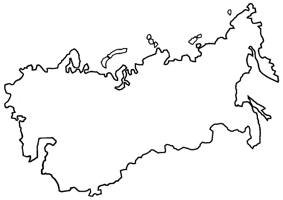
|
The Society of Folk Dance Historians (SFDH) Soviet Union
[
Home |
About |
Encyclopedia | CLICK IMAGE TO ENLARGE |

|
BACKGROUND
Information: A former country (1922-1991).
The Soviet Union, officially the Union of Soviet Socialist Republics (USSR), was a federal socialist state in Northern Eurasia.
Nominally a union of multiple national Soviet republics, it was a one-party state governed by the Communist Party, with Moscow as its capital in its largest republic, the Russian SFSR.
It was the largest country in the world by surface area, spanning over 6,200 miles east to west across eleven time zones and over 4,500 miles north to south. Its territory included much of Eastern Europe, parts of Northern Europe and Western Asia, and all of Northern and Central Asia. Its five climate zones were tundra, taiga, steppes, desert, and mountains. Its diverse population was collectively known as the Soviet people.
The Soviet Union had its roots in the October Revolution of 1917 when the Bolsheviks, headed by Vladimir Lenin, overthrew the Provisional Government that had earlier replaced the monarchy of the Russian Empire. The New Economic Policy (NEP) led to a partial return of a free market and private property; this resulted in a period of economic recovery.
The USSR produced many significant social and technological achievements and innovations of the 20th century, including the world's first ministry of health, first human-made satellite, the first humans in space and the first probe to land on another planet (Venus). The country had the world's second-largest economy and the largest standing military in the world.
With an area of 8,649,500 square miles, the Soviet Union was the world's largest country. Covering a sixth of Earth's land surface, its size was comparable to that of North America.
During World War II, the Red Army stopped the seemingly invincible German Army at the Battle of Moscow. The Battle of Stalingrad, which lasted from late 1942 to early 1943, dealt a severe blow to Germany from which they never fully recovered and became a turning point in the war.
During the immediate post-war period, the Soviet Union rebuilt and expanded its economy, while maintaining its strictly centralized control. It took effective control over most of the countries of Eastern Europe (except Yugoslavia and later Albania), turning them into satellite states. The USSR bound its satellite states in a military alliance, the Warsaw Pact, in 1955.
The countries that made up the Soviet Union were:
- Armenia
- Azerbaijan
- Belarus
- Estonia
- Georgia
- Kazakhstan
- Kyrgyzstan
- Latvia
- Lithuania
- Moldova
- Russia
- Tajikistan
- Turkmenistan
- Ukraine
- Uzbekistan
On 8 December 1991, the presidents of Russia, Ukraine and Belarus (formerly Byelorussia), signed the Belavezha Accords, which declared the Soviet Union dissolved.
Languages: Russian functioned as an official language, the "language of interethnic communication."
Religions: Christianity and Islam had the highest number of adherents among the religious citizens. Eastern Christianity predominated among Christians, with Russia's traditional Russian Orthodox Church being the largest Christian denomination.
This page © 2018 by Ron Houston.
Please do not copy any part of this page without including this copyright notice.
Please do not copy small portions out of context.
Please do not copy large portions without permission from Ron Houston.